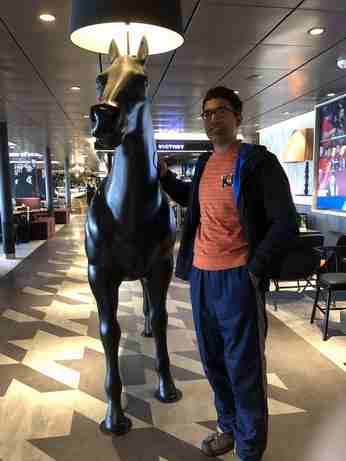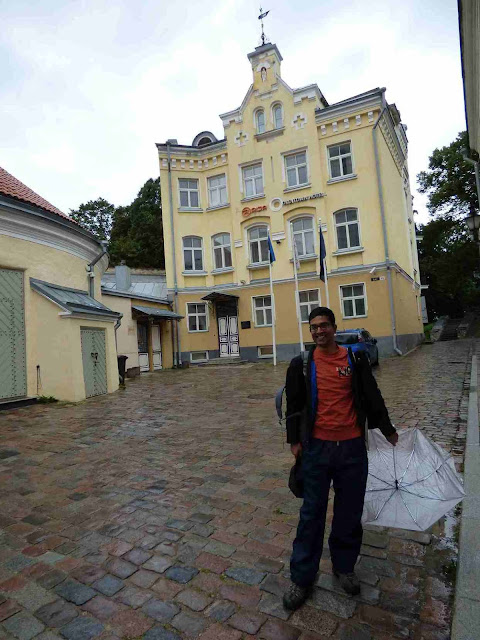
DAY 15 Friday Sep 13, 2019:
We were keen on taking a day trip
to TALLINN from HELSINKI. There are options of carriers and timings.
Discounted return tickets are available only for the day cruise, ie
if we return on the same day. One way trip is costlier than the day
return. So people intending to stay over buy day return tickets for a
better price.
Anyway, we intended to have only a day trip. Only in summer weekends and during holiday season when people make liquor runs to Estonia, advance booking is necessary. We booked tickets just 2 days before.
We also should pay attention to the terminal from where the ferry takes off in Helsinki. Different carriers ave different terminals. n Helsinki, the terminal for Eckerö and Tallink is quite far from centre while the Viking terminal is walkable from Kauppatori in the middle of town. They are all easily reached by tram (7 or 6T for Eckerö & Tallink, 4 or 5 for Viking)..


Anyway, we intended to have only a day trip. Only in summer weekends and during holiday season when people make liquor runs to Estonia, advance booking is necessary. We booked tickets just 2 days before.
We also should pay attention to the terminal from where the ferry takes off in Helsinki. Different carriers ave different terminals. n Helsinki, the terminal for Eckerö and Tallink is quite far from centre while the Viking terminal is walkable from Kauppatori in the middle of town. They are all easily reached by tram (7 or 6T for Eckerö & Tallink, 4 or 5 for Viking)..


We wanted to take the 7.30 am cruise and come back by 6.30 pm. The cruise takes 2 hours. They do have a checkin process and it closes 20 minutes before boarding. We were not too sure about catching the tram on time so early in the morning when frequency will be low. There are taxis available at the Holiday Inn near the train station but we were a little jittery if it'll work out that early. It would mean an early start from our apartment without full guarantee of making the cruise. So we had to go for the 10.30 am cruise. Obviously meant less time in Tallinn and we do regret not spending more time there. It's a LOVELY town. We could hardy do justice in he few hours we had. It would have been a good idea to stay a couple of days, buy the Tallinn card and enjoy the town.
Anyway we had a walking tour planned and we saw the sights following the pins we had on our offline map.
Tallinn has managed to wholly preserve
its structure of medieval and Hanseatic origin. Due to its
exceptionally intact 13th century city plan, the Old Town was
inscribed as a UNESCO World Heritage Site. Here we find original
cobblestone streets dotted with medieval churches and grandiose
merchant houses, barns and warehouses many of which date back to the
Middle Ages.
ROTERMANN QUARTER:
Kicked off our Tallinn walking tour in the Rotermann Quarter. The Rotermann Quarter is an area that consists of former decaying factories and warehouses established in the 19th-century by the industrialist Christian Abraham Rotermann.
Can see St Olaf's church. The church was first mentioned in 1267 and named in honor of King Olaf II of Norway, who was canonized for massacring pagans in Scandinavia. Its eye-catching 124-meter spire is a major Tallinn landmark and the church holds a proud place in the city’s history.
These quirky stone pigeons adorn many roads...
Neglected during much of the Soviet era, in 2007 the district
underwent a major redevelopment and is now home to properties that
are prime inner-city redevelopment territory.
The local architects
got creative by not demolishing these industrial buildings, and just
modernized them by adding additional floors and glass windows, which
look like glass cubes or spinners. The result is pretty cool and
these sleek architectural buildings now house swanky bars, cafés,
boutique shops, offices, and restaurants.
We reached Viru Gate... a row of flower kiosks lined up the street.
VIRU GATE
The iconic Viru Gate serves as one of
the chief entry points into the Old Town. Its two picturesque, skewed
stone towers are one of Tallinn’s major sightseeing attractions.
The pair of towers that make up the gate date to the 14th century and
are surrounded by a stretch of the city wall dating back to the 16th
century.
Although Tallinn began life as a
fortified Estonian trading post, its urban history only commenced in
1219, when it was conquered by the conquering Danes who built a
castle on Toompea Hill. The name “Tallinn” is an abbreviation of
the Estonian name Taani Linnus, meaning “Danish stronghold”.
However, Tallinn officially bore the Teutonic name of Reval until
Estonia’s first period of independence in 1918.
The oldest sections of Tallinn's
city wall were built in the 13th century. During the next three
centuries, it became one of the largest and strongest defence systems
in the entire Northern Europe.
More than a half of the magnificent
defence system has been preserved as a city wall - this includes 1.85
km of the wall, 26 defence towers, 2 gates and fragments of two front
gates.
Patkuli viewing platform is a good place for examining the city wall, and a number of towers are open for visitors.
Patkuli viewing platform is a good place for examining the city wall, and a number of towers are open for visitors.
We have a chance to walk on a small section of the wall that connects the Nunne, Sauna and Kuldjala towers. The wall has a wonderful view of the Old Town and Toompea. We did not have time though.
There are some fun statues along the way. This is Black Angus, the Bull at a steakhouse.
ST. CATHERINE’S PASSAGE
Next up is St. Catherine’s
Passageway.
It is a medieval alleyway joining Vene and Müürivahe
streets with uneven stone walls and overhead vaulting. The passage
runs along the surviving wall of St. Catherine’s Church, which was
built in 1246 and was formerly the largest church in the city.
We can still notice several gravestones here, some dating from the 14th
century. Nowadays, the passage is home to an ensemble of arts and
craft workshops with stained glass, ceramics, leatherwork, millinery,
and jewelry.
There was an old monastery we visited... in an ancient courtyard...
We walked on ...enjoying the medieval flavor.
We reached the Fat Margaret tower.
FAT MARGARET’S TOWER
Out of all of the Old Town’s
remaining towers, the Fat Margaret’s Tower is now home to the
Estonian Maritime Museum and features an interesting collection of
nautical paraphernalia spread out over four levels.
This 16th-century
tower’s suggestive name comes from the fact that it was the largest
part of the city’s fortifications with walls measuring 4 meters
thick. It was initially constructed to defend the harbor as well as
to enthrall visitors arriving by sea. Later, the tower was
transformed into a prison.
Tallinn prospered in the 14th
and 15th centuries when it was one of the leading members of the
mighty Hanseatic League, a commercial and defensive confederation of
merchant guilds and market towns that dominated trade in Northwestern
and Central Europe from the 13th to the 15th century.
We saw a lovely shop with hand painted porcelain and spent quite some time there...
SOUVENIR SHOP:

Bought some stuff and walked on
We looked for The Three Sisters, three
adjoining medieval merchants’ houses that are probably the most
captivating and best-preserved of the Old Town’s gabled merchants’
houses. The houses were built in 1362 and were functional mercantile
areas, complete with loading hatches and winches to hoist sacks of
goods up and down. The houses’ original owners were mainly guild
members, town councilors and burgomasters who used the houses to
entertain foreign guests. Recently, the houses have been converted
into a single luxury hotel in tasteful citrus colors. We could not spot it.
Anyway the architecture was great and we kept walking.
Report of Part 2 of this day continues here:
Anyway the architecture was great and we kept walking.
Report of Part 2 of this day continues here:


































































































This comment has been removed by a blog administrator.
ReplyDelete